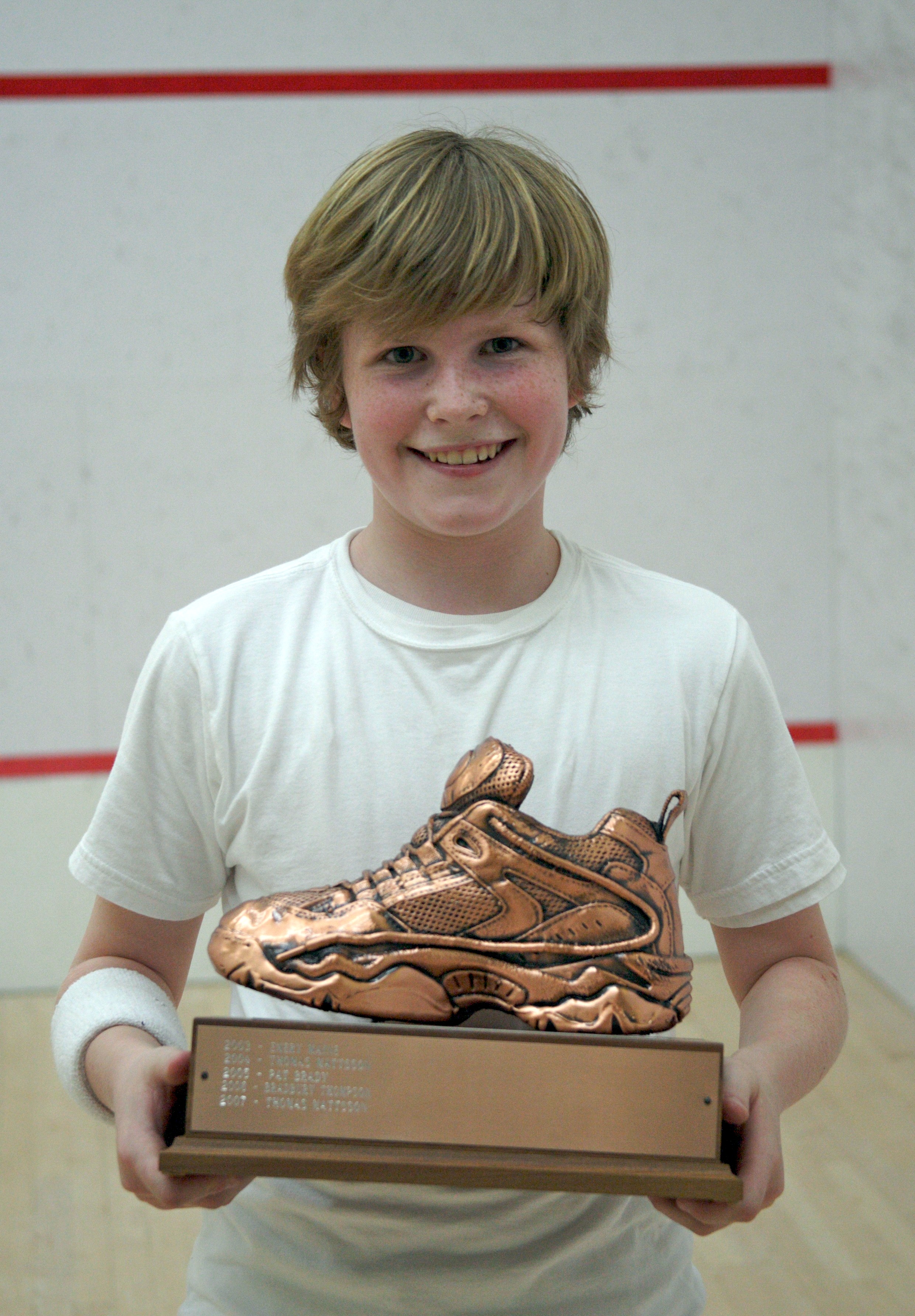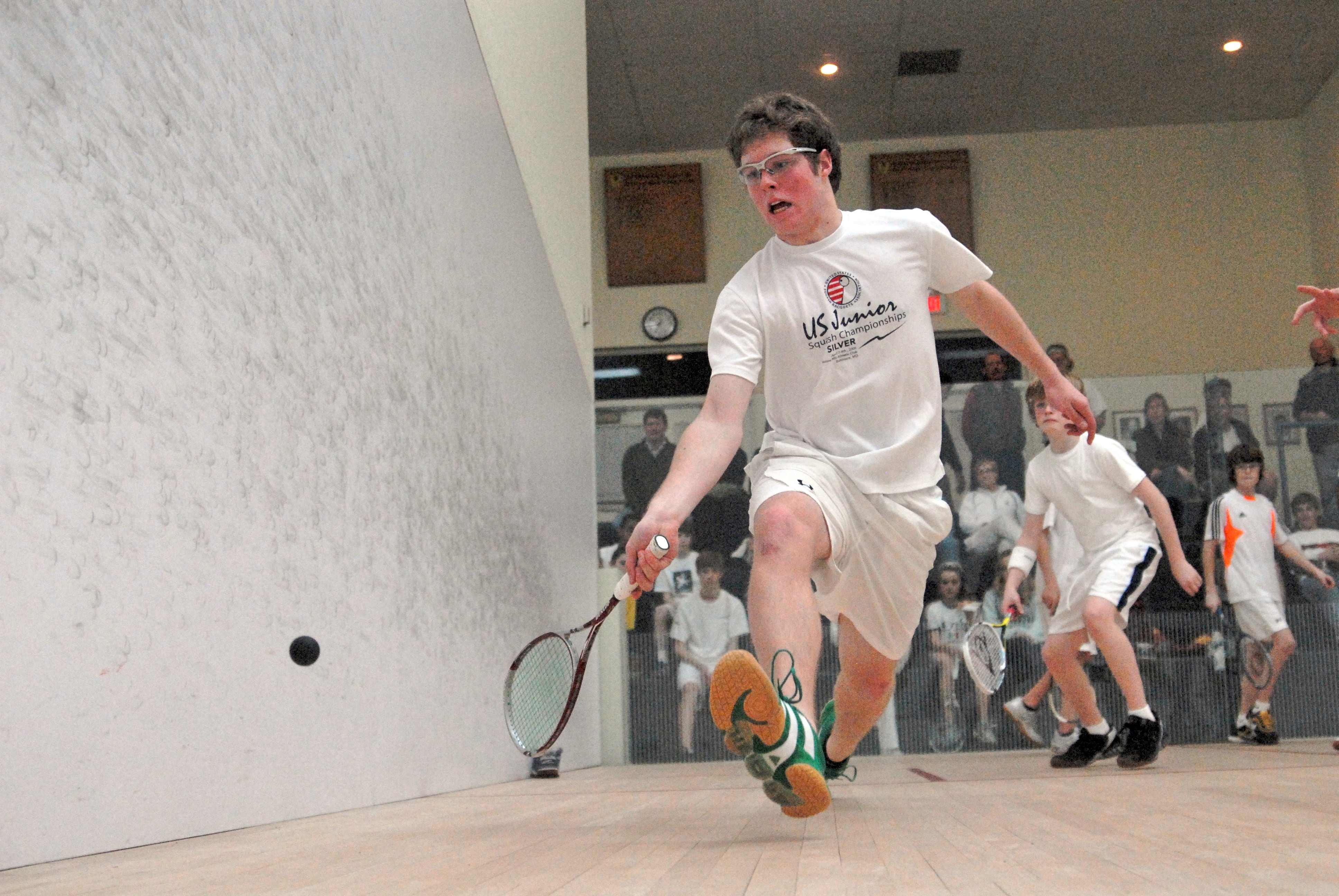
By Joseph Dworetzky
Photos by Sam Sneed
Just before the game begins, there is a moment of quiet. A man walks through the glass door onto the empty squash court. He is dressed entirely in white except for a fedora the color of an old saddle. He holds a squash racquet in one hand and a pair of well-worn blue squash shoes in the other. He places one shoe, toe forward, tight along the right wall, exactly one racquet length from the tin. He moves to the top of the service box and repeats the process.

Nine players stream into the court. They too are dressed in white but there are no fedoras. They have that bug-eyed look that comes with wearing squash goggles.
They are ready. The 2008 Championships are about to start. The name of the game is Shoe.
Shoe is played with as many as a dozen players on the court at one time. Two shoes are placed along the wall of choice; one at the front, the other mid-way in the rear quadrant. The basics of play are similar to King of the Court. If the right wall is the shoe wall, player one serves from the left box. Player two receives the serve in the right quadrant and returns the ball down the right wall where it is hit by player three and then in turn by player four and successor players then the sequence will begin again with the first player, always playing down the shoe wall. If a player fails to return the shot of the preceding player or hits the tin, he gets a point. Seven points and the player is out.
The shoes add an extra dimension. If a player’s shot strikes a shoe, play stops and he is awarded 2, 3 or 4 points, depending on which shoe was struck and whether the shot actually landed in the shoe. The player has several choices. He may deduct up to one point from his own score. Any remaining points must be awarded to other players. Points can be spread around or they may be bundled and dropped, devastatingly, on a single player.
Titus Cranch, the inventor of Shoe, has been an assistant pro at the Philadelphia Cricket Club for the last seven years. A thoughtful man, deeply literate, he has invented all types of games to help teach junior squash; Shoe has proven the most popular and enduring. Thirty players have entered the advanced Shoe championships at the Cricket Club this year. The field has been cut to nine for the finals.
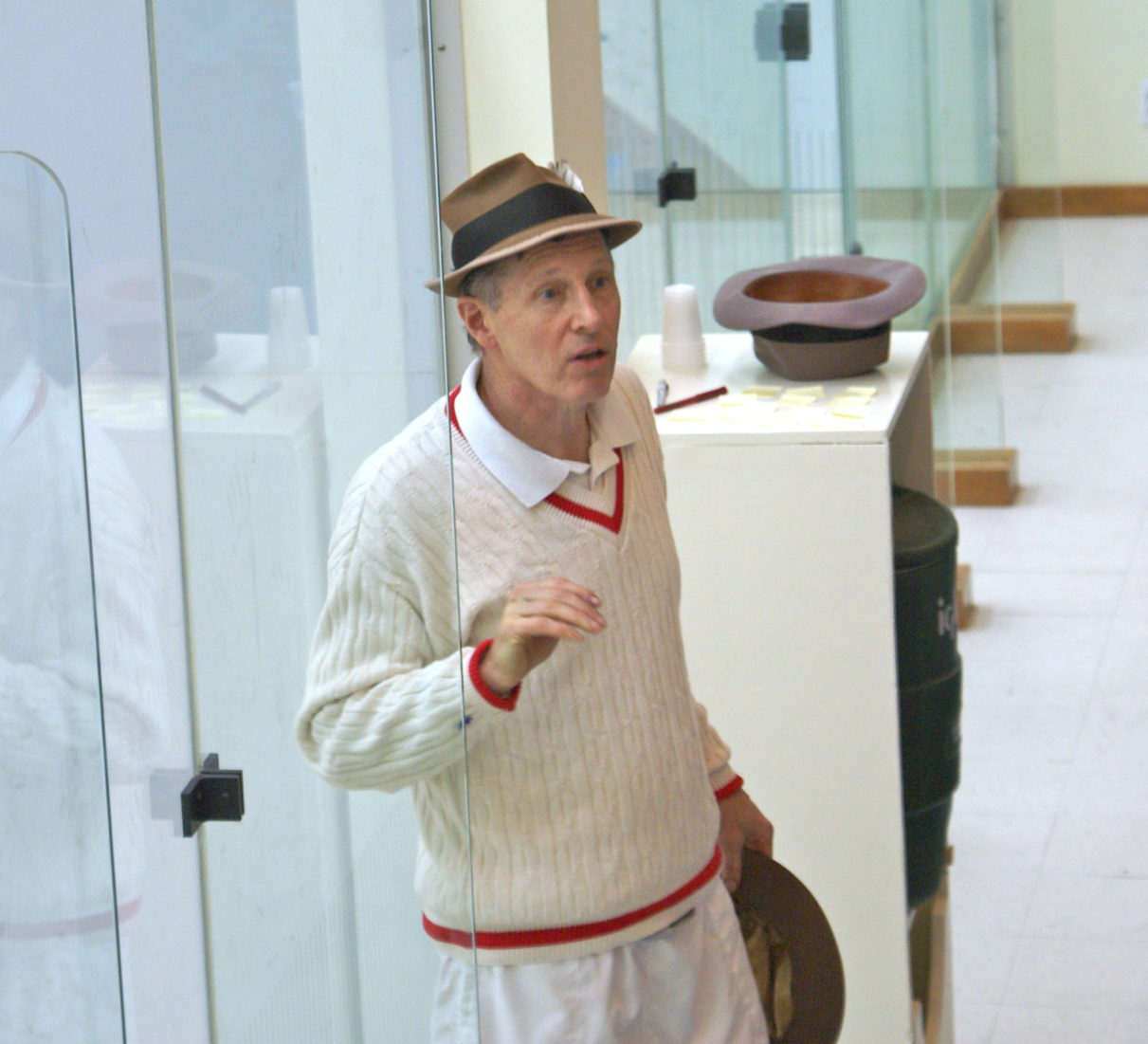
Hunter Beck serves the first ball of the finals. Hunter is in 10th grade at Penn Charter. He plays on the PC team that won the national high school championship in 2007 and 2008. He is over six feet and has a whip to his shot that makes a distinctive and satisfying crack when the ball strikes the front wall. Like many of the players on the court, he has grown up playing Shoe.
Hunter serves to Phillip Kelly, his junior by four years and at least half a foot. Phillip is a dark horse in the championships. Despite a national U13 doubles title, he is not a plausible singles opponent for a player at Hunter’s level. Phillip returns the ball, unsteadily, to Alvaro Sanz.
Alvaro Sanz de Acedo is 50 years old. He learned squash in Spain and plays with grace and a deceptively easy-going demeanor. But deep in a singles match he will swear in Spanish—always at himself, for his manners are perfect—and charge after each shot with grim, red-faced intensity. This is the second year that Alvaro has made the finals, a feat that no other adult has accomplished. Alvaro is a favorite of the crowd but no one gives him much of a chance. In the three years that the Shoe Championships have been open to all ages, no adult has ever won.
Shoe was born out of a limited number of courts and the need to find a way to keep a number of kids busy at once. In the late 1980’s, Titus had observed a coach at a Haverford College camp place a shoe and a racquet on the court to help students to learn to hit to winning length. In the 1990’s, coaching a group of students on a private court, Titus added another shoe and began developing the rules that govern play.
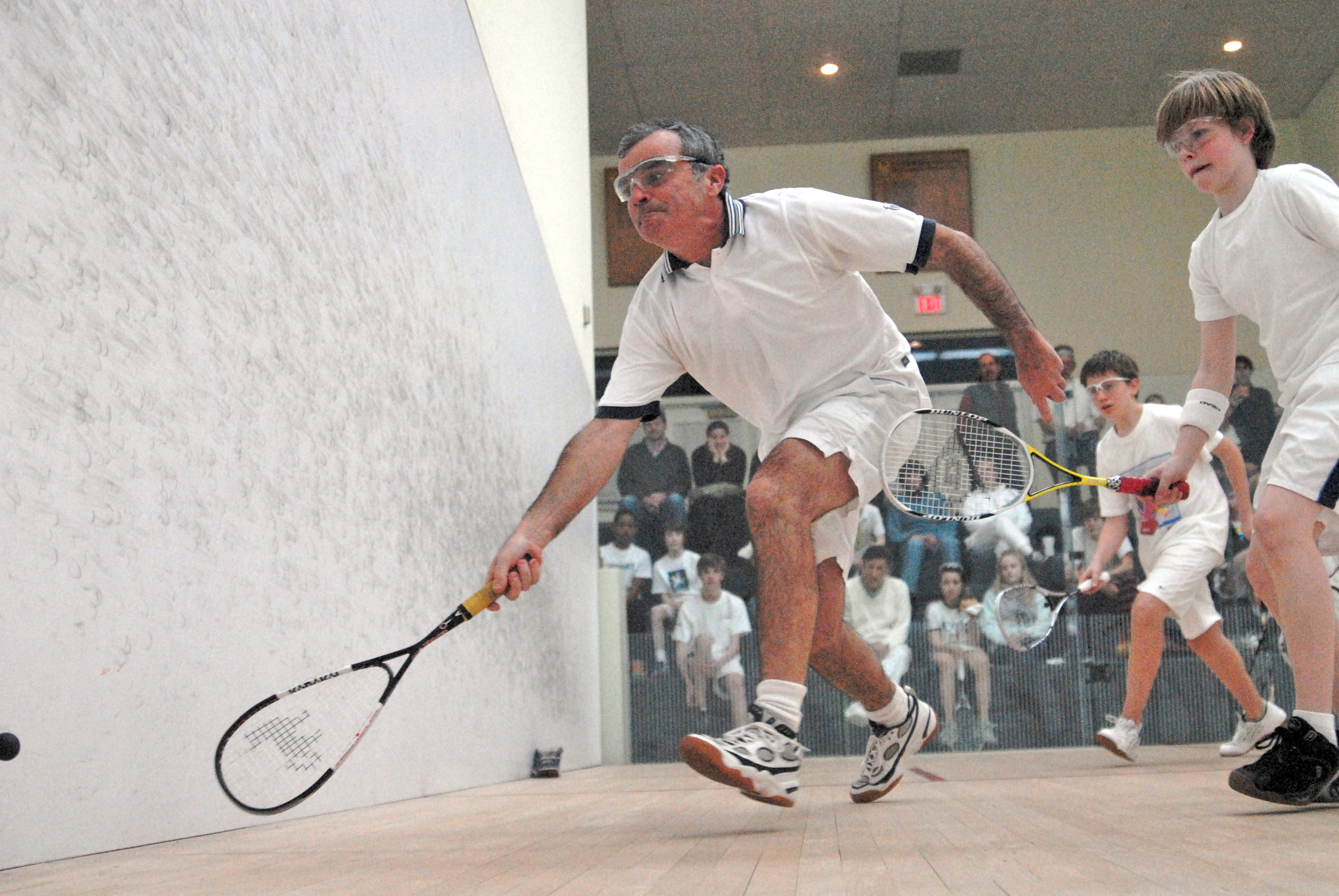
As the rules of the game fell into place, Titus found he really liked watching the kids play the game. He liked the fact that when a player hit a shoe, he had to decide what to do with those points: Whom to anger. Whom to give mercy. Most of all he liked the way “the crows can bring down a hawk.” Shoe is squash combined with Survivor.
Alvaro returns Phillip’s drive to John Canning. John is a 10th grader at Chestnut Hill Academy. He has a steady, long, tight game. Tonight he finished first in rounds one and two. In a moment of seeming generosity, Titus gave him the option of taking a bye straight to the finals. John accepted quickly, but now he has sat out for the last half hour and he is tight while everyone else is loose.
One of the McCall boys drops a shot toward the front shoe, but no one in the crowd knows which McCall boy it is. Alex and Peter McCall are identical twins. Their team at Germantown Friends won the 2008 middle school national championships. They are small but they hit very hard and have a gumby flexibility that lets them extend their reach by a foot in every direction.
Diego Sanz, Alvaro’s 15 year old son, stretches for Alex’s drop and smacks it long and tight, just missing the back shoe, sending Sam Conant scurrying to play the ball off the back wall. Sam is a favorite to win. He finished 2006 as the No. 1 player in the country in the U13s and won the 2007 National U13 Open. Years as a squash rat have given him great touch.
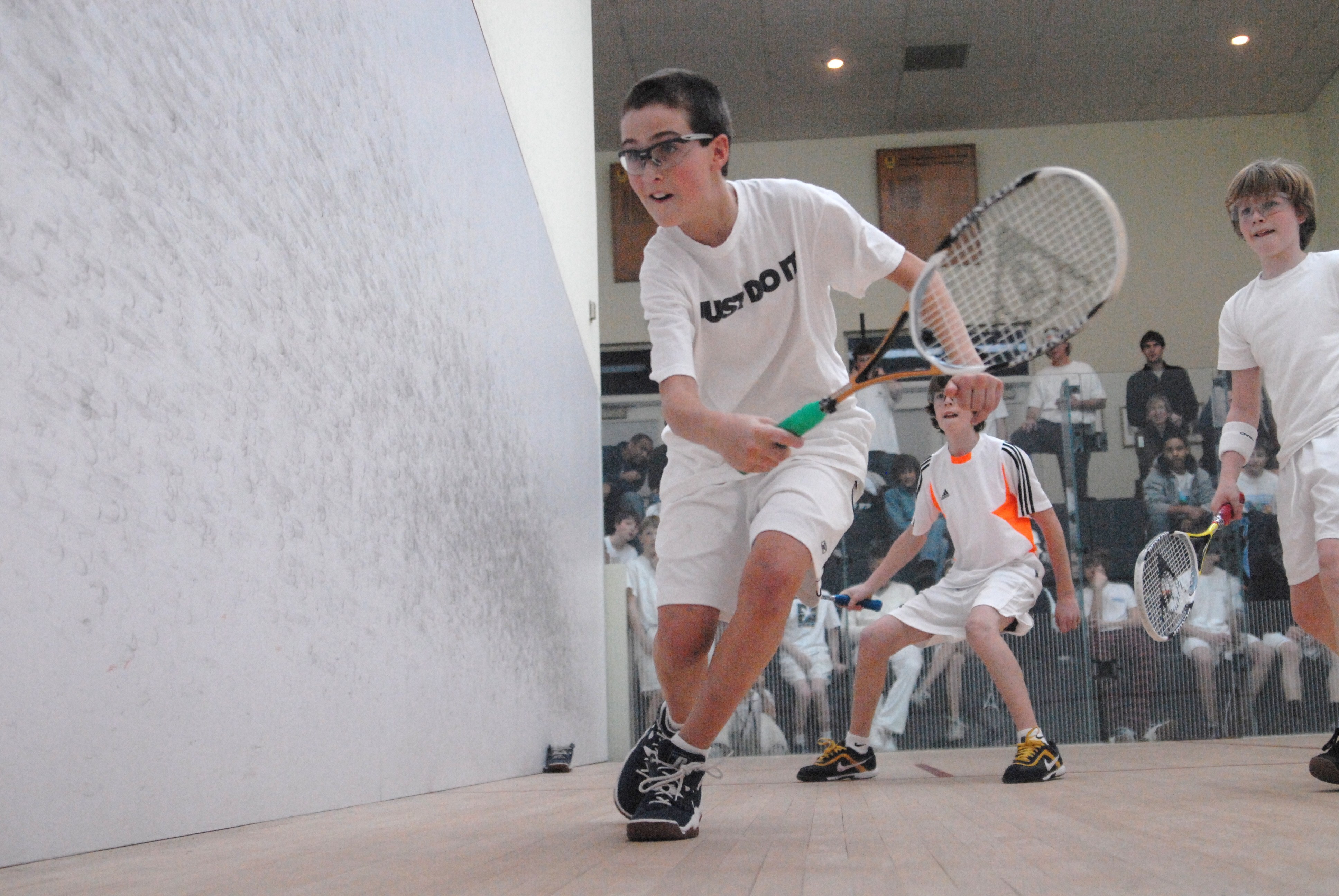
Play continues through the line-up. Each player circles in to the wall and then out as the next player circles in, all nine players moving, jockeying to hit and regroup in sequence. When there are this many people dancing together, a player may get caught out of position in the line-up and must struggle through the pack to get to the shot. Yes, there are lets in Shoe, and yes there are strokes, but amazingly, in the finals, none are requested or awarded.
Alvaro hits the first shoe, a three point shot. He gives himself a negative point and awards two to Hunter Beck. When he hears the award, Hunter doubles over like he has been punched in the gut.
Hunter steps to the line and calls “two!” A player must announce the number of points he has prior to serving. When the server fails to observe this protocol, the other players hoot and yell “Dummy!” and the server picks up an additional point.
Part of what Titus likes about the game is that Shoe is playful. In the cutthroat world of junior tournament squash, he particularly likes that playfulness. “It is playful in the best sense of the word.”
As the game proceeds, there are a surprising number of shoes. Diego, Sam and Randy Beck each hit shoes and by the time those points are awarded, Hunter has 5 and not a single one from missing a shot. There is something, he feels, deeply unfair in his situation. In minutes he is out and the field is down to eight.
Alvaro is next to go. He has been flattered with an award of shoe points—flattered because the award suggests he is a genuine threat—but most of his points are of his own making. Now there are no adults left on the court.
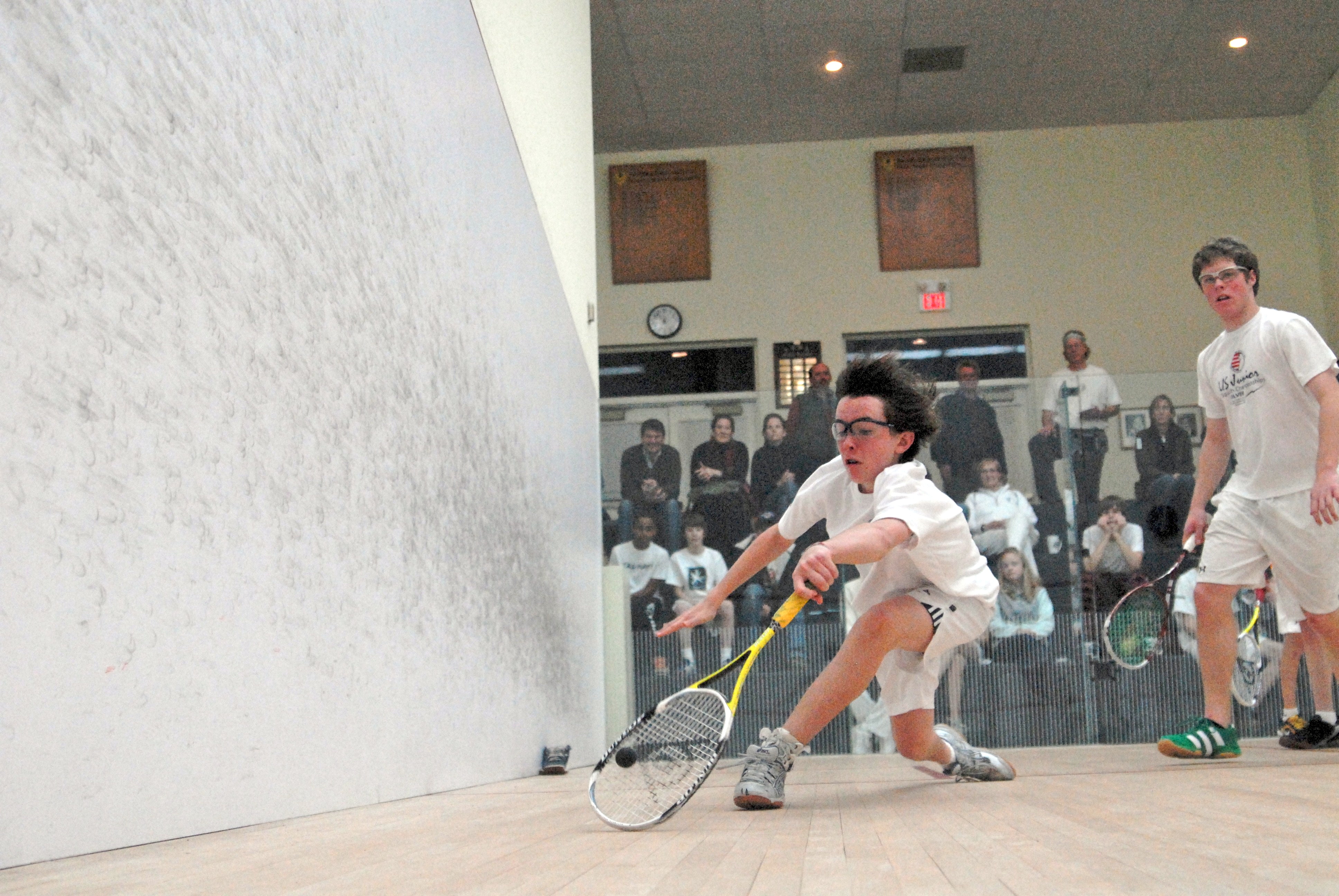
As play continues, Sam Conant keeps picking up shoe points. Particularly with Hunter out of the line-up, Sam is the natural target. Sam can see where this is heading; if he continues to hit safe shots he is going to be eliminated by the other players. He tries a drop for the front shoe from deep on the wall and tins it. A few minutes later he does it again, same result. And then he is gone.
Diego catches fire. He hits three shoes in rapid succession. He makes the tactical choice of spreading the shoe points around. Now everybody is gunning for Diego. If there is anything that a Shoe player remembers, it is who has given him points.
The McCall boy—it turns out to be Alex—hits a shoe. He looks around at the remaining players on the court. None of them will look him in the eye. Randy Beck ducks behind John Canning in the hope the Alex will not see him. Perhaps the strategy pays off, because moments later John is gone. Diego, who has made too many enemies, is not far behind.
With only three players left in the game, there is more room to maneuver but the gap between shots is shorter and the circling tighter. Someone in the crowd observes that the final three players are all middle-schoolers: Randy Beck, Phillip Kelly and Alex McCall. The crows have taken down the hawks.
At this stage, the points are long. Each of the players is playing conservatively. No one wants to pick up a point. They drive straight rails down the wall, all aiming for the back shoe, all bearing down. They don’t look like middle-schoolers at all. These are full grown competitors. Their rails are sharp and consistently tight; their drops are soft.
Phillip Kelly picks the right time to bear down. He hits four shoes in succession and the game is his.
Titus presents the 2008 Shoe trophy to Phillip. The trophy is a full sized bronzed squash shoe, size 8 1/2. Phillip grins and when he does it is obvious that he is just a kid, despite the evidence to the contrary on the court. At 12, he was the youngest player to make the finals.


